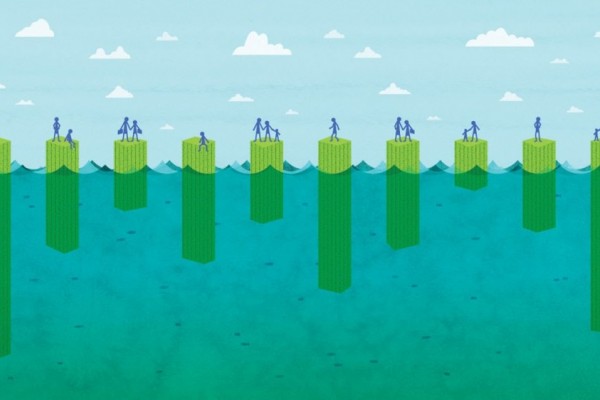From anti to alter-globalization

Participants at an exhibition of antiglobalization protest artwork and films curated by Vienna-based artist Oliver Ressler called A World Where Many Worlds Fit, 2008. Photo by Petra Gerschner.
By the end of the 1980s, various cracks began to appear in the global neoliberal edifice. Partially, they were triggered by early crises that erupted in Mexico, Brazil, Thailand, and Russia, among other countries. The impact of the so-called Washington consensus was making itself felt in the form of massive cuts to public services and jobs and financial shifts that allowed big finance to profit from public and private debt, in addition to privatization and deregulation that put trade unions and other social movements on the defensive. The various fragmented revolts in the 80s were a harbinger of what was to come.
Origins
At the beginning of 1994, the little known southern province of Mexico gained international attention. In Chiapas, the peasant-indigenous population took to the streets under the banner of the Zapatista Liberation Army (EZLN). It was a big surprise, even to the Mexican state, which was taken aback by the scale of the protest and the fact that it was widely supported, even outside Chiapas. The EZLN adopted a new language that distinguished it from earlier liberation movements, emphasizing a non-statist view, local autonomy and non-hierarchical structures. This discourse gained currency worldwide through emerging social media and annual conferences held in the jungles of Chiapas. At the same time, huge protest marches were organized all over Europe and North America against the World Bank, the IMF and WTO, which encountered an exceptionally large gathering of angry protestors at its meeting in Seattle in the fall of 1998. The “Battle of Seattle” was unique in the sense that it brought together a wide variety of social movements, from teamsters (trade unions) to “turtles” (environmental campaigns). In the Americas, north and south, this inaugurated a series of struggles that led to the massive People’s Summit in Québec City in 2001.
The ascending phase
This was not yet a movement, but rather a vast tapestry of initiatives in opposition to neoliberal globalization. These struggles revitalized a number of left-wing think-tanks, publications and organizations in the North. In South America, meanwhile, mass pro-democracy movements were offering real resistance to authoritarian regimes. Coalitions in Brazil, Venezuela, Argentina and later Bolivia and Ecuador came together with a strong grass-roots push and by the beginning of the new millennium, Pink Tide governments were established in many countries. It was during this turbulent phase that movements from the Global North, inspired by developments in the Global South, conceived the idea of creating a platform to recharge policy debates and explore the contours of new visions of social transformation. This laid the groundwork for the World Social Forum. Brazilian-led, the WSF had no clear and explicit strategy, but there was a consensus around the need to build a new framework of analysis. For several years after the founding event, hundreds of thousands of movements and people met in Brazil, and later in India, Mali, Tunisia, Kenya and many other countries, with the aim of developing an alter-globalization perspective.
The WSF process was original because it was an open space where participants themselves were to define the agenda through self-organized political and cultural activities. Much of the work involved drafting an alternative economic program based on the revitalization of the public sector, the decommodification of basic goods and services, new fiscal and financial mechanisms to push back inequalities, local non-market enterprises and the like. At the same time, there was much discussion of how to “democratize democracy,” how to struggle against gender, generational and ethnic discrimination, and how to change the rules of the game to wrest space and opportunities for meaningful citizen participation within the framework of liberal democracy. These immense brainstorming sessions were carried out by many social movements that also took advantage of the WSF to create new international and action-oriented networks, such as Via Campesina and the World March of Women. The WSF methodology was also adopted by hundreds of national and municipal forums in which citizens had a chance to act, play, speak out and express their hopes. It thus helped to bring movements together, create new dynamics and give rise to new projects. One such successful forum was organized in Ottawa in 2012. The Peoples’ Social Forum brought together a critical mass of movements from Canada, Québec and Indigenous communities for the first time in Canadian history.
In its ascending phase, alterglobalization was at once a rallying point for social movements, a political program for the most advanced progressive parties, a living laboratory involving millions of professors, students, intellectuals and artists. It also benefited from concrete support by Pink Tide governments, and particularly Brazil and Venezuela.
Uncertain times
In 2008, global capitalism suffered its most severe crisis since 1929. It shook the Global North first, and within a few years mass mobilizations erupted under the banner of Occupy Wall Street (in Canada and the United States), the Indignados (in Spain and other southern European countries) before crossing the Mediterranean in a historic movement that led to the implosion of long-standing dictatorships, mainly in Egypt and Tunisia. In many ways, these diverse movements all travelled the paths opened up in South America and through the WSF. Unlike in South America, however, they did not have a political counterpart and in the absence of either a European or Maghreb-Mackrek pink tide, the revolts did not succeed in reversing the trends. The countries of the Global North were thus able to steady themselves without too much effort, and the countries of the Global South fell into the grip of resuscitated dictatorship (with the exception of Tunisia). Even where social movements grew strong (in Spain and Greece, for example), the edifice of power was able to withstand the challenge by a combination of local/national reactionary offensives, on the one hand, and international intervention by undemocratic neoliberal institutions, on the other. This counteroffensive also led to the demise of many pink-tide countries – Brazil and Venezuela in particular – which were unable to resist the reactionary assaults in addition to being weakened by their own limitations and contradictions. The World Social Forum was deeply affected by this new and debilitating correlation of forces. The traditional South American leadership of the WSF was blindsided by growing divisions between movements and between movements and pink-tide governments. The WSF in Tunis (2015), Montreal (2016) and Salvador de Bahia (2018) were interesting events, but they lacked the energy and enthusiasm of the past, falling into a bit of a rut rather than innovating and exploring new avenues.
Looking ahead
Although the historic alterglobalization moment has now passed, its ideas and achievements continue to inspire and we can detect its legacy in new forms of resistance. In many countries, admittedly, popular movements are on the defensive and social-democratic reforms are being repealed, while new forms of authoritarianism or “austeritarism” are being imposed. Yet if we look at the situation through a wide-angle lens, we can see expanding cracks in the system, with uprisings multiplying, as in China (Hong Kong), Chile, Sudan, Lebanon, Iraq, Argentina, Algeria, and Columbia. In many more countries, we are seeing ripples that portend big transformative waves. Social movements in many places have become more astute, employing new decentralized strategies. Many have taken the battle for Pachamama to the next level, announcing loudly and clearly that the problem, as Naomi Klein stresses, is not the climate but capitalism. At the same time, an international conversation continues via new forms of networking, such as the Great Transition conference (Montreal, May 2020), the World Social Forum on Transformative Economics (Barcelona, June 2020), the Global Forum on Migration and Development (Quito, January 2020), among many other events and developments. It is still too early, however, to hail the rise of an Alterglobalization 2.0.
Who is reinventing the left?
In the meantime, many left-wing political parties are evolving, scrapping the legacy of past sectarianism, as we have seen, for instance, in the United States (Democratic Socialists of America), Quebec (Québec Solidaire), Chile (Frente Amplio), and England (Momentum). The dark clouds of militarism, racism and fascism are looming everywhere, as evidenced most recently in Bolivia. But in all these places, the power struggles are complex, not predetermined, allowing creative movements to regroup, transcend their past experiences and invent new forms of political and social mobilization. Much more than in past, women, youth and marginalized communities are taking the lead. It is most probably an “interregnum,” to use Gramsci’s phrase, between the black hole of mass destruction and the hope for emancipation.
Pierre Beaudet is a founder and editor of the Nouveaux Cahiers du socialisme.










